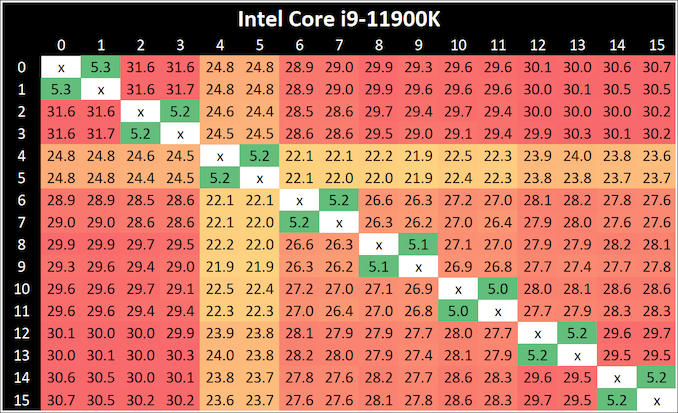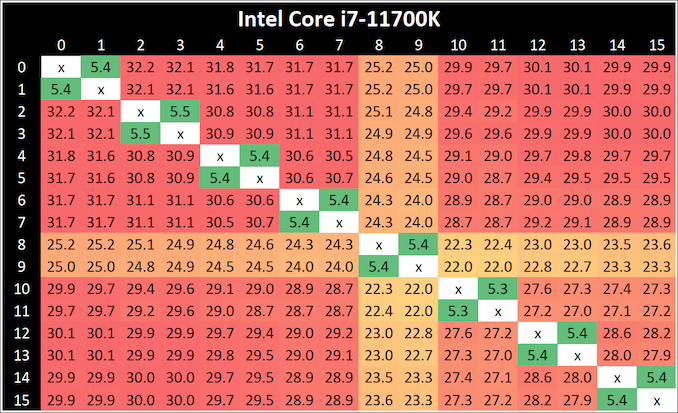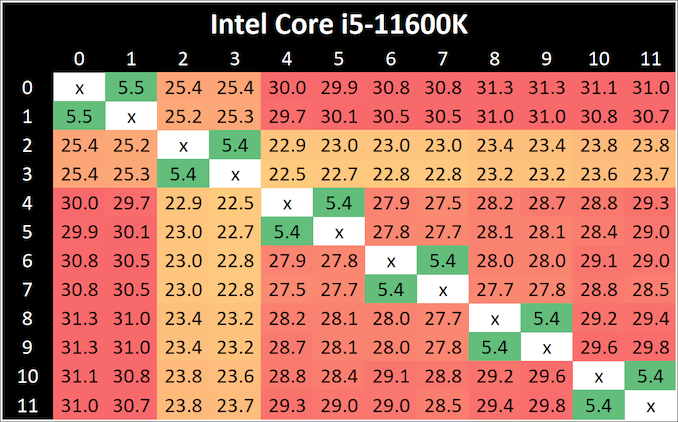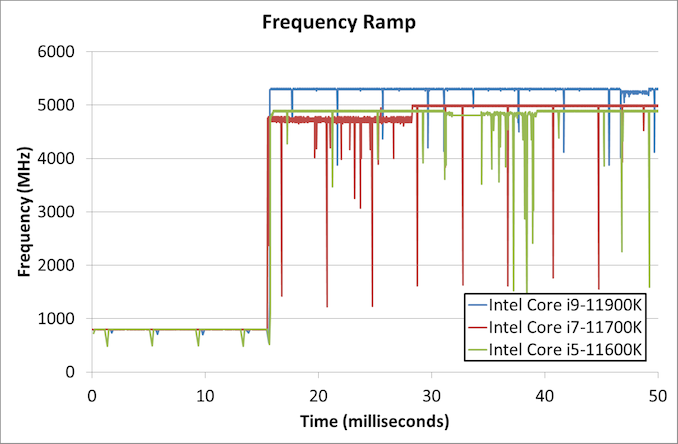Intel Rocket Lake (14nm) Review: Core i9-11900K, Core i7-11700K, and Core i5-11600K
by Dr. Ian Cutress on March 30, 2021 10:03 AM EST- Posted in
- CPUs
- Intel
- LGA1200
- 11th Gen
- Rocket Lake
- Z590
- B560
- Core i9-11900K
CPU Tests: Microbenchmarks
Core-to-Core Latency
As the core count of modern CPUs is growing, we are reaching a time when the time to access each core from a different core is no longer a constant. Even before the advent of heterogeneous SoC designs, processors built on large rings or meshes can have different latencies to access the nearest core compared to the furthest core. This rings true especially in multi-socket server environments.
But modern CPUs, even desktop and consumer CPUs, can have variable access latency to get to another core. For example, in the first generation Threadripper CPUs, we had four chips on the package, each with 8 threads, and each with a different core-to-core latency depending on if it was on-die or off-die. This gets more complex with products like Lakefield, which has two different communication buses depending on which core is talking to which.
If you are a regular reader of AnandTech’s CPU reviews, you will recognize our Core-to-Core latency test. It’s a great way to show exactly how groups of cores are laid out on the silicon. This is a custom in-house test built by Andrei, and we know there are competing tests out there, but we feel ours is the most accurate to how quick an access between two cores can happen.
All three CPUs exhibit the same behaviour - one core seems to be given high priority, while the rest are not.
Frequency Ramping
Both AMD and Intel over the past few years have introduced features to their processors that speed up the time from when a CPU moves from idle into a high powered state. The effect of this means that users can get peak performance quicker, but the biggest knock-on effect for this is with battery life in mobile devices, especially if a system can turbo up quick and turbo down quick, ensuring that it stays in the lowest and most efficient power state for as long as possible.
Intel’s technology is called SpeedShift, although SpeedShift was not enabled until Skylake.
One of the issues though with this technology is that sometimes the adjustments in frequency can be so fast, software cannot detect them. If the frequency is changing on the order of microseconds, but your software is only probing frequency in milliseconds (or seconds), then quick changes will be missed. Not only that, as an observer probing the frequency, you could be affecting the actual turbo performance. When the CPU is changing frequency, it essentially has to pause all compute while it aligns the frequency rate of the whole core.
We wrote an extensive review analysis piece on this, called ‘Reaching for Turbo: Aligning Perception with AMD’s Frequency Metrics’, due to an issue where users were not observing the peak turbo speeds for AMD’s processors.
We got around the issue by making the frequency probing the workload causing the turbo. The software is able to detect frequency adjustments on a microsecond scale, so we can see how well a system can get to those boost frequencies. Our Frequency Ramp tool has already been in use in a number of reviews.
From an idle frequency of 800 MHz, It takes ~16 ms for Intel to boost to the top frequency for both the i9 and the i5. The i7 was most of the way there, but took an addition 10 ms or so.














279 Comments
View All Comments
Fulljack - Wednesday, March 31, 2021 - link
yeah, just bought an AMD Ryzen 7 4750G with much faster Vega 8 graphics than paltry Xe-LP 32 EU that is barely enough for 720p gaming.vanish1 - Wednesday, March 31, 2021 - link
Ryzen 4000 APUs are not available for purchase through retail, only OEMsrUmX - Wednesday, March 31, 2021 - link
You're fucking stupid.jospoortvliet - Thursday, April 1, 2021 - link
That are available in about a week. https://www.anandtech.com/show/9793/best-cpusvanish1 - Thursday, April 1, 2021 - link
Woof a Zen 2 based APU that costs currently $637 on Newegg, ouch.Also, youre missing the point. Instead of overspending and wasting money to game, put the cash towards other parts of the system then focus on gaming when GPU prices return to normal.
Prosthetic Head - Tuesday, March 30, 2021 - link
The past called, they want their processors back!But seriously, it is sad to see back ports on to older processes with (relatively) awful performance / Watt. Talking of which, can anyone point me to a recent power / performance analysis of current CPUs?
Prosthetic Head - Tuesday, March 30, 2021 - link
e.g. sum up the area under these traces from the handbreak test to see the total energy used to do the same job: https://images.anandtech.com/doci/16495/Power-HB.p...Bigos - Tuesday, March 30, 2021 - link
Thanks for Factorio test results. I am looking forward to the Bench DB being filled.Could you share more about the save you are using for the test? Is it a big factory (a "mega base") or something smaller? Is it mostly bot or belt focused? Are trains being used?
wr3zzz - Tuesday, March 30, 2021 - link
Handbrake seems to scale better with additional cores on Rocket Lake than on Zen3. Why is that?29a - Tuesday, March 30, 2021 - link
I had a Zen+ CPU and Handbrake had trouble utilizing all of the cores